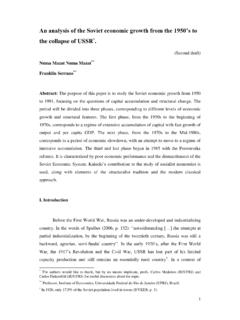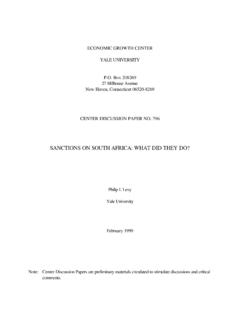Transcription of Chapter 2 Theories of Economic Development
1 Chapter 2 Theories of Economic DevelopmentAbstractThis Chapter reviews some of the most prominent Theories of economicdevelopment. These Theories describe tools and strategies for making developmentgoals achievable. The Chapter starts with early views about the nature of economicprosperity. The Chapter then reviews classical Theories with four main clusters:linear stages of growth models; structural change models; international dependencemodels; and neoclassical counter-revolution models. Subsequently, contemporarytheories of Economic Development , including new growth theory and theory ofcoordination failure, are reviewed.
2 Finally, implications of the changes in thedevelopment thoughts and their importance in studying Development problems inthe developing countries conclude the Development goals Theories of Economic Development Developing countries Classical Theories Contemporary IntroductionThe problems of Economic Development , which are complex and multidimensional,have resulted in the Development of a number of Theories , explanations, argumentsand assertions (World Bank2000). The purpose of this Chapter is to review some ofthe most prominent Theories of Economic Development .
3 These Theories describe toolsand strategies for making Development goals achievable. The Chapter starts with earlyviews about the nature of Economic prosperity. The Chapter then reviews classicaltheories with four main clusters: linear stages of growth models; structural changemodels; international dependence models; and neoclassical counter-revolutionmodels. Subsequently, contemporary Theories of Economic Development , includingnew growth theory and theory of coordination failure, are reviewed. Finally,implications of the changes in the Development thoughts and their importance instudying Development problems in the developing countries conclude the Chapter .
4 Springer Science+Business Media Singapore 2015G. Dang and L. Sui Pheng,Infrastructure Investments in Developing Economies,DOI Goals of Economic growth of Gross National ProductThe goal of Economic Development in its simplest form is to create the wealth of anation. Prior to the 1970s, rapid Economic growth has been considered a goodproxy for other attributes of Development (Todaro and Smith2009). Economicperformance is measured by an annual increase in gross national product (GNP1)[an alternative measure is gross domestic product (GDP)].
5 For the purpose ofcomparability, GNP is expressed in a common currency, usually US dollars, andreported in per-capita terms to take into account the size of a nation s population(Jaffee1998). The World Bank now replaces GNP per capita with gross nationalincome (GNI) per capita to compare wealth among countries. The World Bankdefines GNI as the sum of value added by all resident producers plus any producttaxes (less subsidies) not included in the valuation of output plus net receipts ofprimary income (compensation of employees and property income) from , the World Bank still uses GDP in many other featured economicindicators (World Bank2011).
6 However, the indicator is a measure of well-being and Development exclusivelybased on material wealth. Improvements in welfare such as better health care,education and more housing for large parts of the poor population have not beencaptured. The experience of the 1950s and 1960s has shown that GNP growthwould not necessarily result in a better life for a nation s population. The narrowgoal of Development ( Economic growth ) induced nations to focus their energiesnarrowly on the rapid growth of national incomes (Todaro and Smith2003). Tomaximize income growth , environmental considerations were left to languish on thesidelines; the standard of living was often allowed to slide; large inequalitiesbetween classes, regions, and genders were ignored; and poverty was toleratedmore than it should have been in the rush to generate maximum growth (Basu2000, p.)
7 64). It was then scholars and policy-makers in most developing countrieswho realized that income growth was only one dimension of Development ; a neweconomic view of Development has Quality of LifeDuring the 1970s, the concern of millions of people living subsistence lives inpoverty turned the attention of Development economists to people s lives rather thantheir incomes. Many developing countries have experienced high growth rates of1 GNP is gross domestic product (GDP) plus incomes received by residents from abroad minusincomes claimed by non-residents.
8 GDP is calculated as the value of the totalfinal output of allgoods and services produced in a single year within a country s boundaries (Soubbotina2004).122 Theories of Economic Developmentper-capita income but little change in the living conditions of a large part of thepopulation. By questioning whether it is the goal of Development that per-capitaincome increases but poverty, inequality and unemployment are growing worse,Seers (1969) marked the change needed in setting Development objectives. The goalof Development during the period was thus not limited to Economic growth but toconcentrate on the reduction of poverty, inequality and unemployment (Seers1979).
9 In the 1990s, economists increasingly recognized that it was the quality of life thatdetermines whether people are from developing countries or not. Diseases, mal-nourishment and death that happen in the everyday lives of those from the devel-oping countries changed the view of Development goals dramatically. By then, likemany scholars around the world, Stiglitz (1998) contributed to shift the developmentgoals set by governments in developing countries to wider objectives, includingimprovements in income distribution, environment, health and education.
10 A broaderperspective of Development goals is hence necessary as reflected in the World Bank sDevelopment Report (1991, )as to improve the quality of life. Especially, in theworld s poor countries, a better quality of life generally calls for higher incomes but it involves much more. It encompasses as ends in themselves better education,higher standards of health and nutrition, less poverty, a cleaner environment, moreequality of opportunity, greater individual freedom, and a richer cultural life. Sen s(1985,1992,1999) work perhaps has brought about the broadest per-spective of Development goals.








